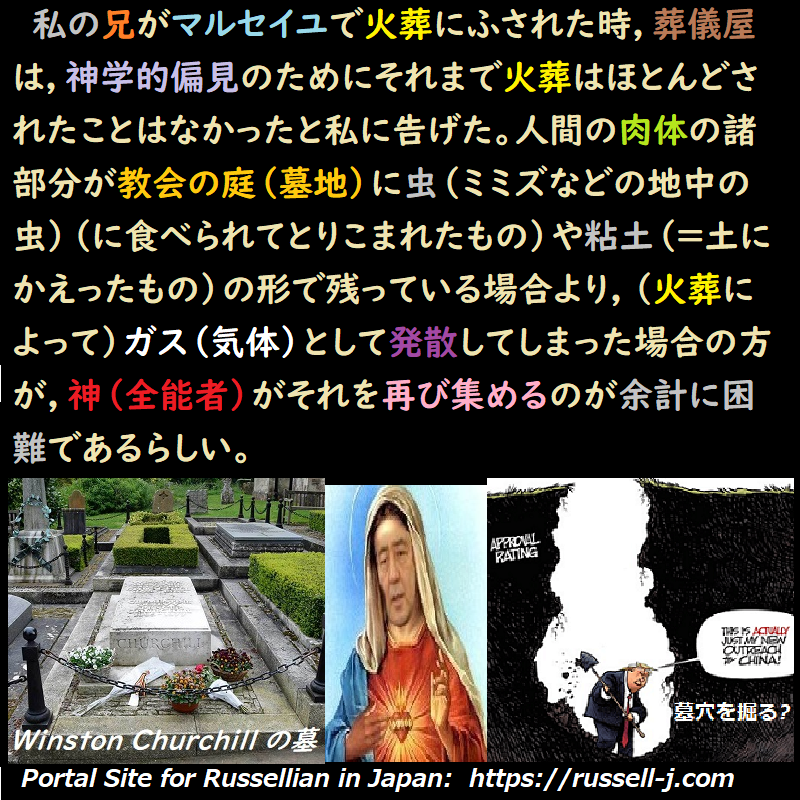
古代世界においてはプラトン的(なもの)だったキリスト教哲学者たちの説も,11世紀以後は,主としてアリストテレス的(なもの)になった。最高のスコラ哲学者(scholastics)として公認されているトマス・アクィナス(1225-1274)は,今日に至るまでローマン・カトリック教会における哲学的正統説の基準とされている。バチカン(=ローマ教皇庁)の統制を受けている教育機関の教師たちは,歴史的関心の問題として,デカルト,ロック,カントあるいはヘーゲルの体系について詳しく説明する一方,唯一の「真実なる」体系は「熾天使博士」(注:the “seraphic doctor : 中世最大のスコラ哲学者の一人であるイタリアの神学者ボナベントゥラ(Bonaventure)の尊称)の体系であることを明白にしなければならない。そこで許される限度は,ボナベントゥラの解釈者がやっているように,ボナベントゥラが,両親が人食いである人食いが復活する(再生する)時に何が起こるかということを論じている時,冗談を言っているのだということを指摘すること位である。(即ち)その人食いとその両親に食べられた人々は,その人食いに対して,自分たちの肉体を新たに構築する優先権があるのは明らかであるので,(関係者の)各々の人が自分の肉体の再構成を求めている場合(には),人食いは欠けた部分があるまま残されるでろう(注:わかりにくいかも知れないがこういことであろう。人食いよりも食べられた人たちの方が良い人達なので,悔い改めた人食いを復活させるよりも前に,まず食べられた人々の肉体を復活(=再生)させてあげなければならない。その場合,人食いの子供は人食いの両親が人食いでない人々を食べることによって成長したのであるから,それらの人食いでない人々をまず復活=再生させたら,そういった人たちを食べて成長した人食いを復活させる場合には「欠けた部分」が出てくるのは必然ということになる,という冗談)。これは使徒信条(Apostles’ Creed)によってお墨付きを与えられている,肉体の再生(蘇り/復活)を信じている人々にとって本当に難しい問題である(注:使徒信条の一節に「われは聖霊、 聖なる公教会、諸聖人の通功、罪の赦し、肉体(肉身)のよみがえり、終りなき命を信じ奉る」とある)。(キリスト教の)正統信仰がそのドグマ(肉体の蘇りの教義)を保持する一方,そのドグマと結びついたぎこちない(下手な)疑問(問題)についての重大な議論を単なる冗談(pleasantry)として扱うことは,現代における(キリスト教)正統信仰の知的衰弱の一つの印(現れ)である。この信仰が今日でも生きていることは,その信仰に由来する火葬への反対においても見られるであろし,火葬に対する反対は,プロテスタント諸国の多くの人々によって抱かれており,またカトリック諸国においてはフランスのように解放されている人々の場合でさえ(も含めて),ほとんど全ての人たちによって抱かれている。私の兄がマルセイユで火葬にふされた時,葬儀屋は,神学的偏見のためにそれまで火葬はほとんどされたことはなかったと私に告げた。人間の肉体の諸部分が教会の庭(の墓地)に虫(ミミズなどの地中の虫)(に食べられてとりこまれたもの)や粘土(=土にかえったもの)の形で残っている場合より,(火葬によって)ガス(気体)として発散してしまった場合の方が,神(Omnipotence 全能者)がそれを再び集めるのが余計に困難であるらしい(注:津田訳では「apparently」を「あきらかである」と訳出しているが、ここでは辞書の2番目にあがっている意味で「神様も難しいらしい」と皮肉が込められている)。このような考え方を私が表明すれば,異端(者)の印(現れ)になるだろう。けれども,それは,実際,最も疑いもない正統信仰の人々の間で支配的なものの見方である。
Chapter V Soul and Body, n.3
The doctrine of Christian philosophers, which was mainly Platonic in the ancient world, became mainly Aristotelian after the eleventh century. Thomas Aquinas (1225- 1274), who is officially considered the best of the scholastics, remains to this day the standard of philosophical orthodoxy in the Roman Catholic Church. Teachers in educational institutions controlled by the Vatican, while they may expound, as matters of historical interest, the systems of Descartes or Locke, Kant or Hegel, must make it clear that the only true system is that of the “seraphic doctor.” The utmost permissible licence is to suggest, as his translator does, that he is joking when he discusses what happens at the resurrection of the body to a cannibal whose father and mother were cannibals. Clearly the people whom he and his parents ate have a prior right to the flesh composing his body, so that he will be left destitute when each claims his own. This is a real difficulty for those who believe in the resurrection of the body, which is affirmed by the Apostles’ Creed. It is a mark of the intellectual enfeeblement of orthodoxy in our age that it should retain the dogma while treating as a mere pleasantry a grave discussion of awkward problems connected with it. How real the belief still is may be seen in the objection to cremation derived from it, which is held by many in Protestant countries and by almost all in Catholic countries, even when they are as emancipated as France. When my brother was cremated at Marseilles, the undertaker informed me that he had had hardly any previous cases of cremation, because of the theological prejudice. It is apparently thought more difficult for Omnipotence to reassemble the parts of a human body when they have become diffused as gases than when they remain in the churchyard in the form of worms and clay. Such a view, if I were to express it, would be a mark of heresy ; it is in fact, however, the prevailing opinion among the most indubitably orthodox.
出典:Religion and Science, 1935, chapt. 5:
情報源:https://russell-j.com/beginner/RS1935_05-030.HTM
